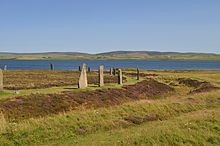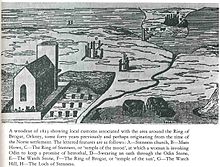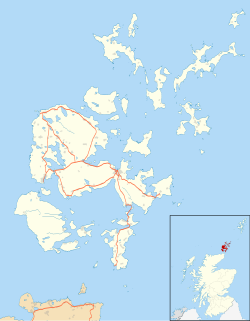Ring of Brodgar
 The ring withLoch of Harraybeyond | |
 | |
| Location | Mainland, Orkney,Scotland |
|---|---|
| Coordinates | 59°00′05″N3°13′47″W/ 59.0014818°N 3.2297227°W |
| Type | Standing stones,henge |
| History | |
| Periods | Neolithic |
| Site notes | |
| Ownership | Historic Scotland[needs update] |
| Public access | Yes |
| Type | Cultural |
| Criteria | i, ii, iii, iv |
| Designated | 1999(23rdsession) |
| Part of | Heart of Neolithic Orkney |
| Reference no. | 514 |
| Region | Western Europe |
| Identifiers | |
| Historic Environment Scotland | SM90042 |
TheRing of Brodgar(orBrogar,orRing o' Brodgar) is aNeolithichengeandstone circleabout 6 miles north-east ofStromnessonMainland,the largest island inOrkney,Scotland. It is part of theUNESCOWorld Heritage Siteknown as theHeart of Neolithic Orkney.
General information
[edit]
The Ring of Brodgar (or Brogar, or Ring o' Brodgar) is a Neolithichengeandstone circlein Mainland, Orkney, Scotland. It is the only major henge and stone circle in Britain which is an almost perfect circle. Most henges do not contain stone circles; Brodgar is a striking exception, ranking withAveburyandStonehengeamong the greatest of such sites.[1]The ring of stones stands on a smallisthmusbetween theLochs of StennessandHarray.These are the northernmost examples of circle henges in Britain.[2]Unlike similar structures such as Avebury, there are no obvious stones inside the circle,[3]but since the interior of the circle has never been excavated byarchaeologists,the possibility remains that wooden structures, for example, may have been present. The site has resisted attempts at scientific dating and the monument's age remains uncertain. It is generally thought to have been erected between 2500 BC and 2000 BC, and was, therefore, the last of the great Neolithic monuments built on the Ness.[4]A project called The Ring of Brodgar Excavation 2008 was undertaken in the summer of that year in an attempt to settle the age issue and help answer other questions about a site that remains relatively poorly understood.[5]The results of the excavation are still preliminary.
The stone circle is 104 metres (341 ft) in diameter, and the third largest in the British Isles.[4]The ring originally had up to 60 stones, of which only 27 remained standing at the end of the 20th century. The tallest stones stand at the south and west of the ring, including the "Comet Stone" to the south-east.[6]: 42 The stones are set within a circular ditch up to 3 metres (9.8 ft) deep, 9 metres (30 ft) wide and 380 metres (1,250 ft) in circumference that was carved out of the solid sandstone bedrock by the ancient residents.[7]Technically, this ditch does not constitute a true henge as there is no sign of an encircling bank of earth and rock. Many archaeologists continue to refer to this structure as a henge; for example,Aubrey Burlclassifies the ditch as a Class II henge; one that has two opposing entrances, in this case on the north-west and south-east.[8]
The ditch appears to have been created in sections, possibly by workforces from different parts of Orkney. The stones may have been a later addition, maybe erected over a long period of time.[6]: 42
Examination of the immediate environs reveals a concentration of ancient sites, making a significantritual landscape.Within 2 square miles (5.2 km2) there are the two circle-henges, four chambered tombs, groups of standing stones, single stones, barrows, cairns, and mounds.[9]The immediate area has also yielded a number of flint arrowheads and broken stone mace-heads that seem to date from theBronze Age.[10]Although its exact purpose is not known, the proximity of theStanding Stones of Stennessand itsMaeshowetomb make the Ring of Brodgar a site of major importance. The site is ascheduled monumentand has been recognized as part of the "Heart of Neolithic Orkney"World Heritage Sitein 1999.
World Heritage status
[edit]TheHeart of Neolithic Orkneywas inscribed as a World Heritage site in December 1999. In addition to the Ring of Brodgar, the site includesMaeshowe,Skara Brae,theStanding Stones of Stennessand other nearby sites. It is managed by Historic Environment Scotland, whose 'Statement of Significance' for the site begins:
The monuments at the heart of Neolithic Orkney and Skara Brae proclaim the triumphs of the human spirit in early ages and isolated places. They were approximately contemporary with the mastabas of the archaic period of Egypt (first and second dynasties), the brick temples of Sumeria, and the first cities of the Harappa culture in India, and a century or two earlier than the Golden Age of China. Unusually fine for their early date, and with a remarkably rich survival of evidence, these sites stand as a visible symbol of the achievements of early peoples away from the traditional centres of civilisation...The Ring of Brodgar is the finest known truly circular late Neolithic or early Bronze Age stone ring and a later expression of the spirit which gave rise to Maeshowe, Stenness and Skara Brae[11]
The first formal survey of the Ring of Brodgar and surrounding antiquities was performed in 1849 byRoyal NavyCaptainF.W.L. Thomasof HMcutterWoodlark.[12]Captain Thomas was in the area drawing upAdmiralty Chartsin 1848–49, and he and his crew performed archaeological surveys as well resulting in the publication in 1852 ofThe Celtic Antiquities of Orkney.[13]
Excavations of Neolithic ruins
[edit]
Ongoing excavations byOrkney Collegeat the nearbyNess of Brodgarsite located roughly midway between the Ring and the Stones of Stenness have uncovered several buildings, both ritual and domestic. Geophysics suggest there are likely to be more in the vicinity. Pottery, bones, stone tools and a polished stone mace head have also been discovered. Perhaps the most important find is the remains of a large stone wall which may have been 100 metres (330 ft) long and up to 6 metres (20 ft) wide. It appears to traverse the entire peninsula the site is on and may have been a symbolic barrier between the ritual landscape of the Ring and the mundane world around it.[14]
Nordic rites
[edit]
Invaders from Scandinavia reached Orkney by the 9th century, bringing a complex theology that they imposed on the preexisting Orcadian monuments; at least according to local legend. For example, the Ring of Brodgar and the Standing Stones of Stenness were allegedly known as the Temple of the Sun and Moon respectively.[15]Young people supposedly made their vows and prayed toWōdenat these "temples" and at the so-called "Odin Stone" that lay between the stone circles until it was destroyed by a farmer in 1814.[15]Others view these fanciful names with skepticism; Sigurd Towrie suggests that "they were simply erroneous terms applied by the antiquarians of the 18th or 19th centuries – romantic additions, in the same vein as the infamous" Druid's Circle "and" Sacrificial Altar "."[16]At the very least, several of the stones at Brodgar contain runic carvings that were left byNordic peoples.[17]These include the name "Bjorn" and a small cross as well as an anvil.[6]: 42
"Megalithic Yard" and Neolithic astronomers at Brodgar
[edit]

Burl[18]notes that the diameter of the bank at Brodgar is almost exactly the same as the inner banks of theAveburymonument inEnglandand theNewgrangering inIreland:125 "megalithic yards"(MY), at 0.8297 metres (2.722 ft) per MY. This is a controversial unit originally proposed byAlexander Thom.[19]Thom's thesis, based on a statistical analysis ofNeolithicmonuments in the United Kingdom, is that the builders of these sites employed a common unit of measurement, although it has not been demonstrated how this information could have been shared:.[20]
Heggie casts doubt on this as well, stating that his careful analysis uncovered "little evidence for a highly accurate unit" and "little justification for the claim that a highly accurate unit was in use".[21]Thom and his father made other controversial contentions, for example, that Brodgar and the burial mounds that surround it were designed specifically as backsights for astronomical observations of theMoon.[22]Graham Ritchie points out that the burial mounds have not been reliably dated, and he casts doubt on the astronomical prowess of the builders.[23]
Euan MacKie suggested that the nearbyvillageofSkara Braemight be the home of a privileged theocratic class of wise men who engaged in astronomical and magical ceremonies at sites like Brodgar and Stenness.[24]Graham and Anna Ritchie cast doubt on this interpretation noting that there is no archaeological evidence for the claim,[25]although a Neolithic "low road" connects Skara Brae with the chambered tomb of Maeshowe, passing near Brodgar and Stenness.[26]Low roads connect Neolithic ceremonial sites throughout Britain.
Cultural impact
[edit]The Ring of Brodgar features inKathleen Fidler's 1968 novelThe Boy with the Bronze Axe;here, it is depicted in a midsummer ceremony in which a lamb is sacrificed. In Fidler's story, women are forbidden from entering the Ring, which is a male-only space.[27]
InTroika Games2001 titleArcanum: Of Steamworks and Magick Obscura,the Ring of Brodgar appears in the town of Roseborough and is pivotal to the plot.
See also
[edit]Notes
[edit]- ^Ritchie 1985, p. 119
- ^Hawkes 1986, p. 261
- ^Hadingham, 1975, pp.55–56
- ^ab"The Ring of Brodgar, Stenness, Orkney".www.orkneyjar.com.Retrieved2 April2018.
- ^"Orkneyjar Archeology News - The Ring of Brodgar Excavation 2008".www.orkneyjar.com.
- ^abcWickham-Jones, Caroline (2012).Monuments of Orkney.Historic Scotland.ISBN978-1-84917-073-4.
- ^Hawkes 1986, p. 262
- ^Burl 1976, p. 101
- ^Laing 1974, p. 84
- ^Childe 1952, p. 35
- ^"The Heart of Neolithic Orkney".Historic Scotland. Retrieved on 5 September 2007
- ^Hedges 1984, p. 22
- ^Thomas, F. W. L.(1852)"Account of some of the Celtic antiquities of Orkney, including the Stones of Stenness, Tumuli, Picts-houses, etc. with plans"Archived2009-06-24 at theWayback MachineArchaeologia34.pp. 88–136. Retrieved 31 August 2008.
- ^Ross, John (14 August 2007) "Experts uncover Orkney's new Skara Brae and the great wall that separated living from dead". Edinburgh.The Scotsman.
- ^abHedges 1984, p. 13
- ^Sigurd Towrie."The Temples of the Sun and Moon: True tradition or romantic addition?".Orkneyjar.Archived fromthe originalon 20 January 2017.Retrieved23 May2018.
- ^Laing 1974, p. 233
- ^Burl 1976, p. 99
- ^Thom 1955
- ^Burl 1976, p. 71
- ^Heggie 1981 p. 58
- ^Thom & Thom 1973
- ^Ritchie 1985, p. 127
- ^MacKie 1977
- ^Ritchie 1981, pp. 51–52
- ^Castleden 1987, p. 117
- ^Bramwell 2009,p. 184.
References
[edit]- Burl, Aubrey (1976).The Stone Circles of the British Isles.London: Yale University Press.ISBN0-300-01972-6.
- Bramwell, Peter (2009).Pagan Themes in Modern Children's Fiction: Green Man, Shamanism, Earth Mysteries.New York: Palgrave Macmillan.ISBN978-0-230-21839-0.
- Castleden, Rodney (1987).The Stonehenge People.London: Routledge & Kegan Paul Ltd.ISBN0-7102-0968-1.
- Childe, V. Gordon; W. Douglas Simpson (1952).Illustrated History of Ancient Monuments: Vol. VI Scotland.Edinburgh: Her Majesty's Stationery Office.
- Hadingham, Evan (1975).Circles and Standing Stones: An Illustrated Exploration of the Megalith Mysteries of Early Britain.New York: Walker and Company.ISBN0-8027-0463-8.
- Hawkes, Jacquetta (1986).The Shell Guide to British Archaeology.London: Michael Joseph.ISBN0-7181-2448-0.
- Hedges, John W. (1984).Tomb of the Eagles: Death and Life in a Stone Age Tribe.New York: New Amsterdam.ISBN0-941533-05-0.
- Heggie, Douglas C. (1981).Megalithic Science: Ancient Mathematics and Astronomy in North-west Europe.London: Thames and Hudson.ISBN0-500-05036-8.
- Laing, Lloyd (1974).Orkney and Shetland: An Archaeological Guide.Newton Abbott: David and Charles Ltd.ISBN0-7153-6305-0.
- MacKie, Euan (1977).Science and Society in Prehistoric Britain.London: Palgrave Macmillan.ISBN0-312-70245-0.
- Ritchie, Graham & Anna (1981).Scotland: Archaeology and Early History.New York: Thames and Hudson.ISBN0-500-27365-0.
- Ritchie, Graham (1985). "Ritual Monuments". In Renfrew, Colin (ed.).The Prehistory of Orkney BC 4000–1000 AD.Edinburgh: Edinburgh University Press.ISBN0-85224-456-8.
- Thom, A. & Thom A.S. (1973). "A megalithic lunar observatory in Orkney: the Ring of Brodgar and its cairns".Journal of Historical Astronomy.4(2): 111–123.Bibcode:1973JHA.....4..111T.doi:10.1177/002182867300400203.S2CID125682973.
- Thom, Alexander (1955). "A Statistical Examination of the Megalithic Sites in Britain".Journal of the Royal Statistical Society. Series A (General).118 part III (3): 275–295.doi:10.2307/2342494.JSTOR2342494.
- Wainwright, G.J. (1969). "A review of henge monuments in the light of recent research".Proceedings of the Prehistoric Society.35:112–133.doi:10.1017/S0079497X00013426.S2CID191407800.
External links
[edit] Media related toRing of Brodgarat Wikimedia Commons
Media related toRing of Brodgarat Wikimedia Commons
- Buildings and structures completed in the 3rd millennium BC
- 1849 archaeological discoveries
- World Heritage Sites in Scotland
- Archaeological sites in Orkney
- Stone circles in Orkney
- Prehistoric Orkney
- Stone Age sites in Scotland
- Henges in Scotland
- Historic Scotland properties in Orkney
- Tourist attractions in Orkney
- Scheduled monuments in Scotland
- Neolithic Scotland
- Archaeoastronomy
- Mainland, Orkney
- Heart of Neolithic Orkney




